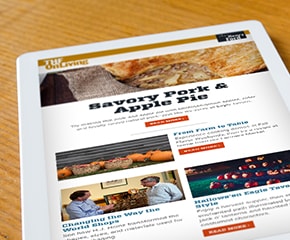
50 Years of High Design in Home Radio
9 artifacts in this set
This expert set is brought to you by:
The staff at The Henry Ford
Sparton Radio Model 558-B, 1937
Radio receiver
This 1937 Sparton radio was designed by Walter Dorwin Teague, a designer renowned for his use of streamlined forms. A study in contrasts -- the blue mirrored finish and curved sled-like base suggest speed while the five jutting parallel panels appear almost architectural -- this expensive and glamorous radio had a limited market during the Great Depression.
Model E-514 Temple Radio, 1945
Radio receiver
Industrial designer Peggy Ann Mack took over the design firm of her late husband, Gilbert Rohde, after his sudden death in 1944. She hoped to continue the firm's design work but despite having ample expertise, some clients didn't want to hire a woman. Commissions were scarce. But in 1945, Templetone Radio hired Mack to redesign showroom interiors and radio cases, including this Model E-514.
Detrola Radio, Model 57IX, 1946
Radio receiver
An architect by training, Alexander Girard was a multi-talented designer. Prior to his illustrious career as director of the textile division for the Herman Miller Furniture Company, Girard was commissioned to redesign the Detroit-based Detrola Radio & Television Corporation's cafeteria in 1943. Detrola then hired him as head designer in 1945. During his tenure, he designed numerous radio cases, including this one.
Philco Transitone Portable Radio, Model 49-602, 1948-1949
Portable radio
This radio marks several shifts in radio design and materials. As manufacturers began using plastic for radio case designs, the color palette widened. Transitone consumers could choose between ivory, maroon, brown, and green. This unit also echoes the rising trend of portability. Tube-driven radios like this would eventually yield to competition from the spread of transistor technology in the mid-1950s.
Crosley Portable Radio, Model E15-TN, 1953
Portable radio
This Crosley "Coloradio" tabletop radio was part of a product line named to highlight the wide range of colors its Bakelite case came in. This radio is notable for the influence of contemporary automobile styling upon its design. Many of Crosley's 1950s radios featured flashy chrome trim, fashionable colors, and circular dials reminiscent of automobile grills and instrument panels.
Heathkit Portable AM Transistor Radio, Model XR-2P, circa 1962
Transistor radio
The Heath Company was founded in the 1920s as a "do-it-yourself" electronics kit provider. "Heathkits" provided simple, accessible instructions understandable to amateurs and experts alike. As hobbyists built radios, televisions, and computers from scratch, they gained electronics skills. These kits were not novelties, but emphasized access to affordable, advanced, high-performance technology. Parallels can easily be seen within present-day...
Weltron Model 2001 Eight-Track Tape Player, circa 1970
Eight-track player
This tape player combined the newest audio format with the spaciest design. Eight-track tape became popular in the mid-1970s; unlike vinyl records, eight-tracks wouldn't skip and could be played in moving cars. This Weltron 2001 eight-track tape player was well-named: its design evokes the 1968 film "2001: A Space Odyssey," and other visions of our future in space.
Zenith "My Radio" Pendant Transistor Radio, circa 1970
Transistor radio
The size of radios shrank following the advent of transistor technology. Even the smallest vacuum tubes were bulky, and their power consumption ensured the need for large batteries. Transistor radios made of lightweight plastics were cheap and truly portable. With the addition of an earphone a radio such as this allowed the listener to enjoy a completely personal listening experience.
Sharp QT 50 Portable Radio Cassette Player, 1986
Radio receiver
In the early 1980s Japanese electronics manufacturers began to develop a sense of how to shape American tastes in design, terming their approach "lifestyle design." This boombox represents the first example of a Japanese electronics firm tapping into the international trend toward postmodernist design. It references 1930s American streamline design, while simultaneously drawing inspiration from 1950s American vernacular design.


